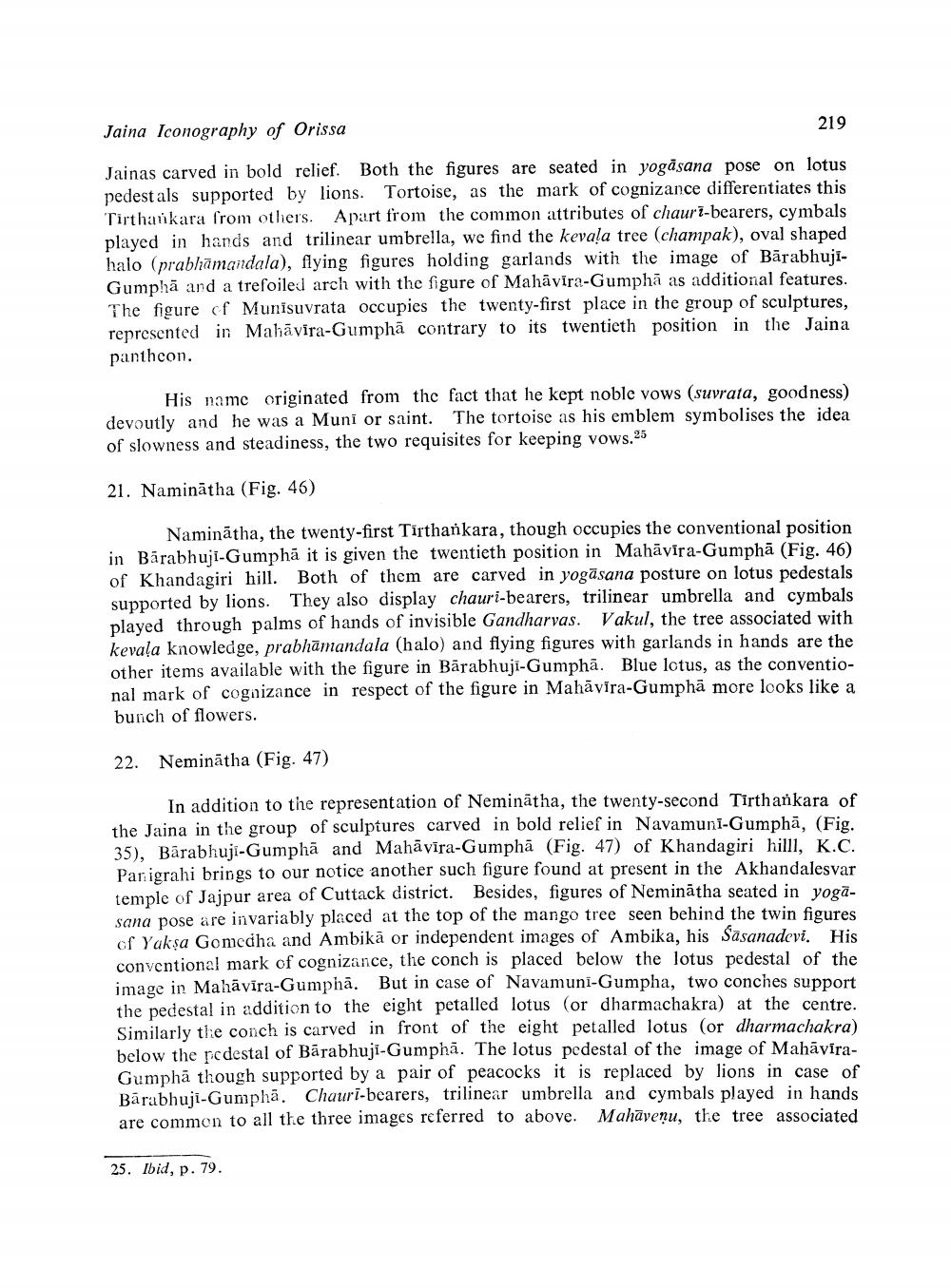________________
219
Jaina Iconography of Orissa
Jainas carved in bold relief. Both the figures are seated in yogasana pose on lotus pedestals supported by lions. Tortoise, as the mark of cognizance differentiates this Tirthankara from others. Apart from the common attributes of chauri-bearers, cymbals played in hands and trilinear umbrella, we find the kevala tree (champak), oval shaped. halo (prabhamandala), flying figures holding garlands with the image of Barabhujt Gumpha and a trefoiled arch with the figure of Mahavira-Gumphã as additional features. The figure of Munisuvrata occupies the twenty-first place in the group of sculptures, represented in Mahavira-Gumpha contrary to its twentieth position in the Jaina. pantheon.
His name originated from the fact that he kept noble vows (suvrata, goodness) devoutly and he was a Muni or saint. The tortoise as his emblem symbolises the idea of slowness and steadiness, the two requisites for keeping vows.25
21. Naminatha (Fig. 46)
Naminatha, the twenty-first Tirthankara, though occupies the conventional position in Barabhujt-Gumphâ it is given the twentieth position in Mahavira-Gumpha (Fig. 46) of Khandagiri hill. Both of them are carved in yogasana posture on lotus pedestals supported by lions. They also display chauri-bearers, trilinear umbrella and cymbals. played through palms of hands of invisible Gandharvas. Vakul, the tree associated with kevala knowledge, prabhamandala (halo) and flying figures with garlands in hands are the other items available with the figure in Bärabhuji-Gumphã. Blue lotus, as the conventional mark of cogaizance in respect of the figure in Mahavira-Gumphã more looks like at bunch of flowers.
22. Neminatha (Fig. 47)
In addition to the representation of Neminatha, the twenty-second Tirthankara of the Jaina in the group of sculptures carved in bold relief in Navamuni-Gumpha, (Fig. 35), Barabhuji-Gumpha and Mahavira-Gumpha (Fig. 47) of Khandagiri hilll, K.C. Panigrahi brings to our notice another such figure found at present in the Akhandalesvar temple of Jajpur area of Cuttack district. Besides, figures of Neminatha seated in yogasana pose are invariably placed at the top of the mango tree seen behind the twin figures of Yoksa Gomedha and Ambikä or independent images of Ambika, his Sasanadevi, His conventional mark of cognizance, the conch is placed below the lotus pedestal of the image in Mahavira-Gumphã. But in case of Navamuni-Gumpha, two conches support the pedestal in addition to the eight petalled lotus (or dharmachakra) at the centre. Similarly the conch is carved in front of the eight petalled lotus (or dharmachakra) below the pedestal of Barabhuji-Gumphã. The lotus pedestal of the image of MahaviraGumpha though supported by a pair of peacocks it is replaced by lions in case of Barabhujt-Gumpha. Chauri-bearers, trilinear umbrella and cymbals played in hands. are commen to all the three images referred to above. Mahaveņu, the tree associated
25. Ibid, p. 79.




